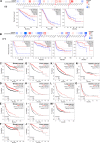A pan-cancer analysis of thioredoxin-interacting protein as an immunological and prognostic biomarker
- PMID: 35843949
- PMCID: PMC9288722
- DOI: 10.1186/s12935-022-02639-2
A pan-cancer analysis of thioredoxin-interacting protein as an immunological and prognostic biomarker
Abstract
Background: The critical role of thioredoxin-interacting protein (TXNIP) in cellular sulfhydryl redox homeostasis and inflammasome activation is already widely known, however, no pan-cancer analysis is currently available.
Methods: We thus first explored the potential roles of TXNIP across thirty-three tumors mainly based on The Cancer Genome Atlas and Gene Expression Omnibus datasets.
Results: TXNIP is lowly expressed in most cancers, and distinct associations exist between TXNIP expression and the prognosis of tumor patients. TXNIP expression was associated with tumor mutational burden, microsatellite instability, mismatch repair genes, tumor infiltrating immune cell abundance as well as cancer-associated fibroblasts. Moreover, ubiquitin mediated proteolysis, protein post-translational modification and other related pathways were involved in the functional mechanisms of TXNIP.
Conclusions: Our first pan-cancer study comprehensively revealed the carcinostatic role of TXNIP across different tumors. And this molecule may be considered as a potential immunological and prognostic biomarker.
Keywords: Genetic alteration; Immune infiltration; Pan-cancer; Prognosis; TXNIP; Ubiquitination.
© 2022. The Author(s).
Conflict of interest statement
The authors declare that the research was conducted in the absence of any commercial or financial relationships that could be construed as a potential conflict of interest.
Figures






References
Grants and funding
- A2020143/Guangdong Medical Science and Technology Research Fund Project
- 2018C027/Foundation of Nanfang Hospital, Southern Medical University
- 12026605/National Natural Science Foundation of China
- 2021A1515010992/Basic and Applied Basic Research Foundation of Guangdong Province
- 2020A1515110916/Basic and Applied Basic Research Foundation of Guangdong Province
LinkOut - more resources
Full Text Sources

